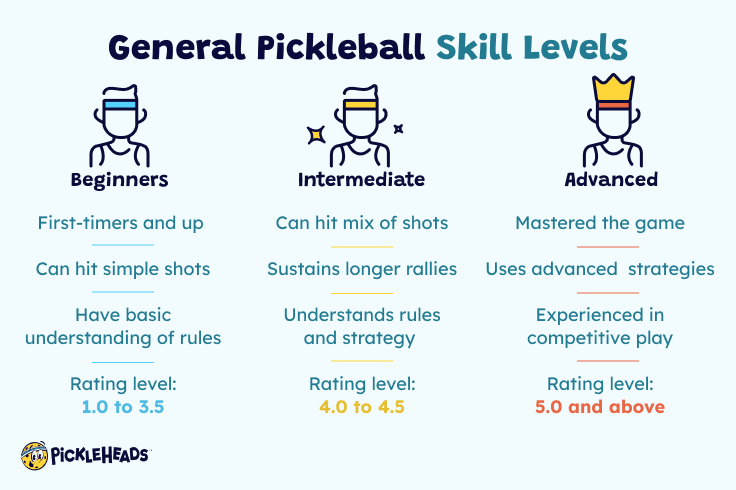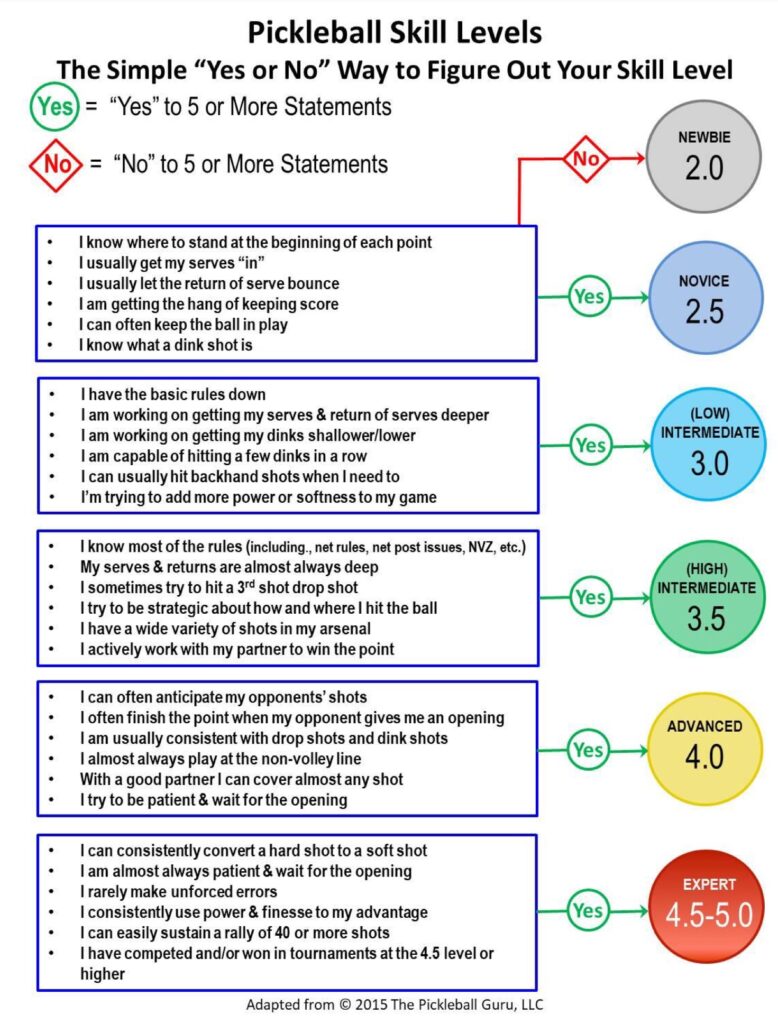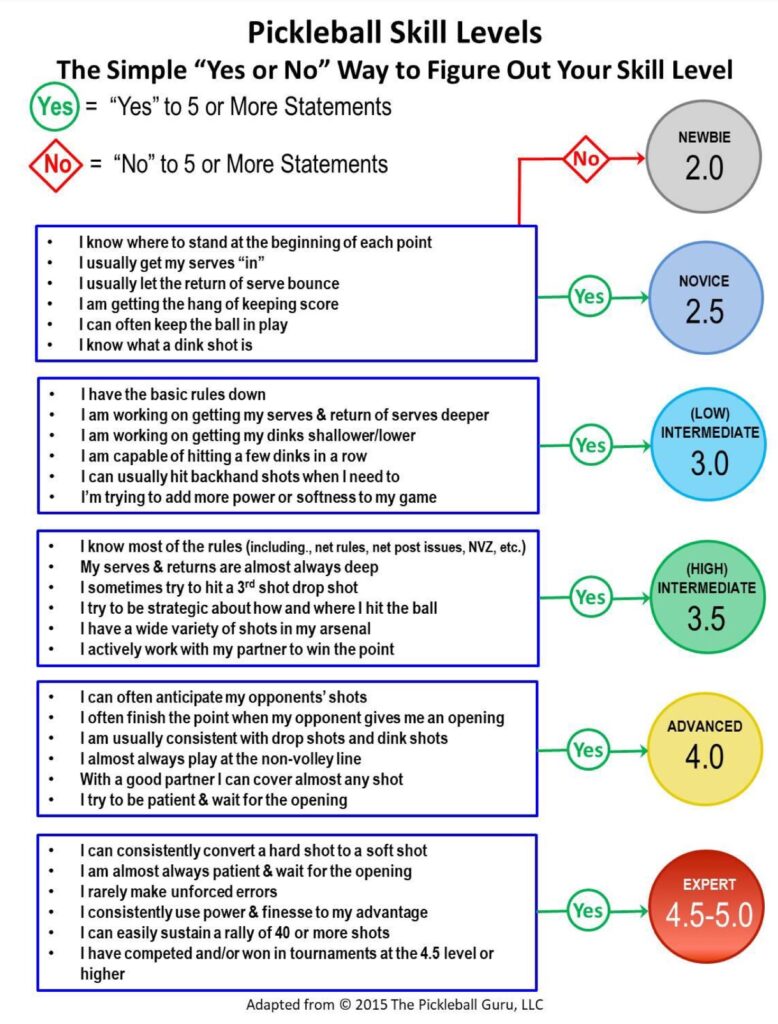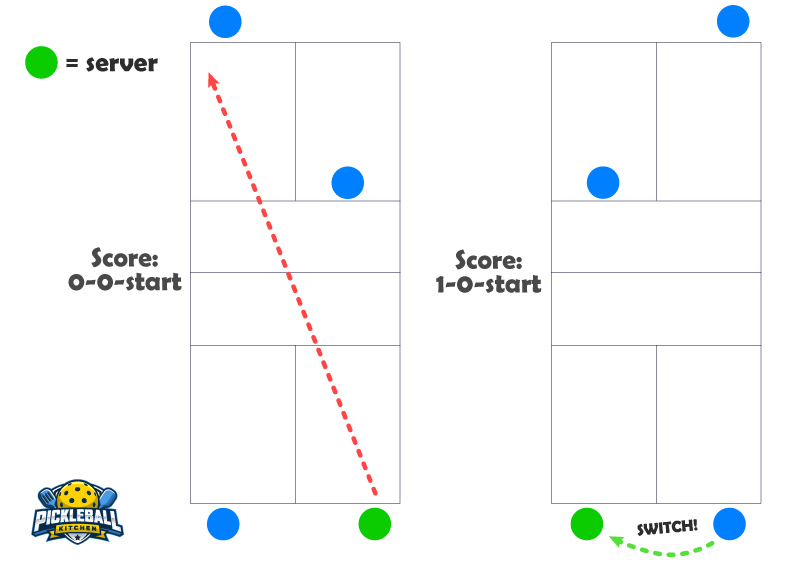The different levels of pickleball include beginner, intermediate, advanced, and professional. Pickleball is a quickly growing sport that appeals to players of all skill levels.
Whether you are new to the game or a seasoned player, there is a level that suits your abilities. The beginner level is ideal for those just starting out, with a focus on learning the basic rules and techniques. Intermediate players have a good understanding of the game and can execute shots with more consistency.
Advanced players possess advanced skills and strategies, allowing them to compete at a higher level. Professional players are the top-tier athletes who compete in tournaments and showcase mastery in all aspects of the game. With its varying levels, pickleball offers something for everyone to enjoy.

Credit: www.pickleheads.com
Beginner Level
Pickleball has different levels for players, with the beginner level being the starting point. Players at this level are just starting to learn the rules and basic techniques of the game.
Basic Rules And Skills
In the world of pickleball, the beginner level serves as a crucial starting point for anyone looking to dive into this exciting sport. As a beginner, it’s important to familiarize yourself with the basic rules and skills that make pickleball both fun and challenging. By understanding these foundational elements, you’ll be well-equipped to take your first steps on the court and start enjoying this fast-paced game.
Here are the basic rules and skills you need to know as a beginner:
1. Rules: Pickleball is played on a court that is similar in size to a badminton court, with a net dividing it into two halves. The game is typically played in doubles, with two players on each team. The objective is to hit a ball over the net, ensuring it clears the net and lands within the boundaries of the opposing team’s half. The serving team must serve the ball diagonally underhand, and the receiving team must let it bounce once before returning it. The ball is only in play when it has cleared the net on the serve and has been returned by the receiving team. Play continues until one team fails to hit the ball back into the opponent’s court.
2. Skills: As a beginner, it’s important to develop basic skills such as proper grip, footwork, and shot selection. Start by mastering the ready position, where your feet are shoulder-width apart and your knees are slightly bent. This stance allows for quick movement and stability. Next, learn the different strokes used in pickleball, including the serve, forehand, backhand, and volley. Practice your aim and control, aiming for consistency rather than power at this stage. Lastly, work on your footwork to ensure you can quickly move around the court and position yourself for optimal shot placement.
Equipment
When it comes to equipment, pickleball requires minimal gear, making it easy for beginners to get started without breaking the bank. Here’s what you’ll need:
1. Pickleball Paddle: A pickleball paddle is similar to a tennis racket but smaller in size. It is usually made of lightweight materials like graphite or composite. When choosing a paddle, consider factors such as weight, grip size, and overall feel. Test different paddles to find one that suits your preferences and playing style.
2. Pickleball: The pickleball itself is a perforated plastic ball with holes, similar to a wiffle ball. It is available in different colors, but the most common color is yellow. Beginners may prefer using indoor pickleballs, as they are slightly softer and slower, allowing for better control.
3. Court Shoes: Invest in a good pair of court shoes designed for indoor or outdoor play. These shoes provide the necessary grip, support, and stability required for quick movements on the court.
Playing Strategies
To enhance your gameplay as a beginner, consider the following strategies:
1. Placement over Power: Focus on placing the ball strategically rather than relying solely on power. Aim to hit shots into the opponent’s weaknesses or corners of the court, forcing them into difficult positions.
2. Work on Communication: Effective communication with your partner is crucial in doubles play. Develop a system of signals or verbal cues to coordinate your movements and shot selection.
3. Learn to Dink: Dinking is a key skill in pickleball, involving short, soft shots that arc over the net and land close to the net on the opponent’s side. This shot disrupts the opponent’s rhythm and can set up opportunities for winning points.
4. Stay Consistent: As a beginner, focus on maintaining consistency in your shots. By reducing errors and keeping the ball in play, you can gradually improve your game and build confidence.
Remember, pickleball is a sport that rewards practice and perseverance. Embrace the beginner level as an opportunity to learn and enjoy the game’s nuances. With time, dedication, and a focus on continuous improvement, you’ll progress to more advanced levels and explore the full potential of this exciting sport.

Credit: www.paddletek.com
Intermediate And Advanced Levels
Pickleball has different levels of play, including intermediate and advanced. These levels offer more challenging gameplay for players looking to take their skills to the next level.
Once you’ve mastered the beginner level of pickleball, you may find yourself itching to take your skills to the next level. That’s where the intermediate and advanced levels come in. Let’s dive into what these levels entail:
Advanced Techniques
At the advanced level of pickleball, players are expected to have a solid grasp of the basic techniques and strategies but are ready to step up their game. Here are some advanced techniques that players often focus on:
- Third Shot Drop: This technique involves intentionally hitting a soft shot after the serve to force your opponents to hit the ball upward, giving you an advantage in the rally.
- Dink Shots: Dinking is a critical skill at the advanced level, which requires players to hit the ball softly over the net, placing it strategically to control the pace of the game.
- Erne Shot: The Erne shot is an advanced shot where players shuffle towards the non-volley zone and volley the ball from a slightly outside position.
- Split-Step: The split-step is a technique used to quickly react and move to the next shot. Advanced players utilize this technique to anticipate their opponent’s shots and maintain a strong position on the court.
Tournaments And Competitions
For those looking to test their skills against other pickleball enthusiasts, tournaments and competitions provide the perfect opportunity. At the intermediate and advanced levels, players can take part in both local and national tournaments. These events not only offer a chance to showcase your skills but also allow you to learn from other talented players and gain invaluable experience.
| Tournament/Competition | Location | Date |
|---|---|---|
| US Open Pickleball Championships | Naples, Florida | April |
| Pickleball Tournament of Champions | Ogden, Utah | August |
| Pickleball Global Challenge Cup | Las Vegas, Nevada | October |
Training And Practice
Becoming an intermediate or advanced pickleball player requires dedication and focused practice. Here are some key aspects of training and practice at these levels:
- Physical Conditioning: Advanced players prioritize physical fitness, incorporating strength training, agility exercises, and endurance workouts into their routine to maintain optimal performance on the court.
- Drills and Skill Development: Advanced players consistently work on drills that target specific skills such as volleys, dinks, and serve returns to further enhance their technique and overall game.
- Mental Preparation: The mental aspect of the game becomes increasingly important at the intermediate and advanced levels. Players focus on techniques like visualization, positive self-talk, and maintaining a competitive mindset.
- Coaching and Strategy: Seeking guidance from experienced coaches offers valuable insights into advanced strategies, shot placement, and tactics specific to pickleball.
As you progress through the intermediate and advanced levels of pickleball, remember that consistency and practice are key. Developing your skills, participating in tournaments, and seeking guidance will help you reach new heights in the sport. Whether you aim to become a competitive player or simply want to enjoy the game at a higher level, the intermediate and advanced levels of pickleball offer exciting challenges and opportunities for growth.

Credit: www.boulderjcc.org
Frequently Asked Questions
How Do You Know What Skill Level You Are In Pickleball?
To determine your skill level in pickleball, consider factors such as your experience, ability to execute shots, understanding of the game’s rules, and performance in matches against players of varying levels. Assessing these aspects can help gauge your proficiency and identify your skill level in pickleball.
What Is A 3.5 Level Pickleball Player?
A 3. 5 level pickleball player is someone with intermediate skills. They have a good understanding of the game and can consistently hit the ball over the net. They are comfortable with basic strategies and can handle moderately paced shots.
What Is A 2.5 Pickleball Player?
A 2. 5 pickleball player is a beginner who is new to the sport and still learning the rules and basic techniques. They have limited experience and may struggle with consistency and control during gameplay.
How Many Levels Are In Pickleball?
Pickleball has various skill levels, starting from beginner to advanced.
Conclusion
To summarize, pickleball offers players a range of skill levels, from beginner to advanced. Whether you’re just starting out or looking to hone your skills, understanding the different levels of pickleball is crucial. Each level presents its own set of challenges and opportunities for growth.
By familiarizing yourself with the various levels, you can join the right group, enjoy competitive matches, and continuously improve your game. So, embrace the world of pickleball, find your level, and start playing!
Neil jacobson is an avid Pickleball enthusiast, writer, and coach dedicated to sharing the joy and intricacies of the sport. With 6 years of experience on the court and a passion for teaching, Courtney brings a unique perspective to his writing, offering practical insights and strategies for players of all levels. As a certified Pickleball coach, his mission is to inspire and empower individuals to excel in the game while fostering a sense of community within the Pickleball world. Through his articles, guides, and coaching sessions, Neil aims to elevate the playing experience and share the infectious enthusiasm that defines the Pickleball community.



